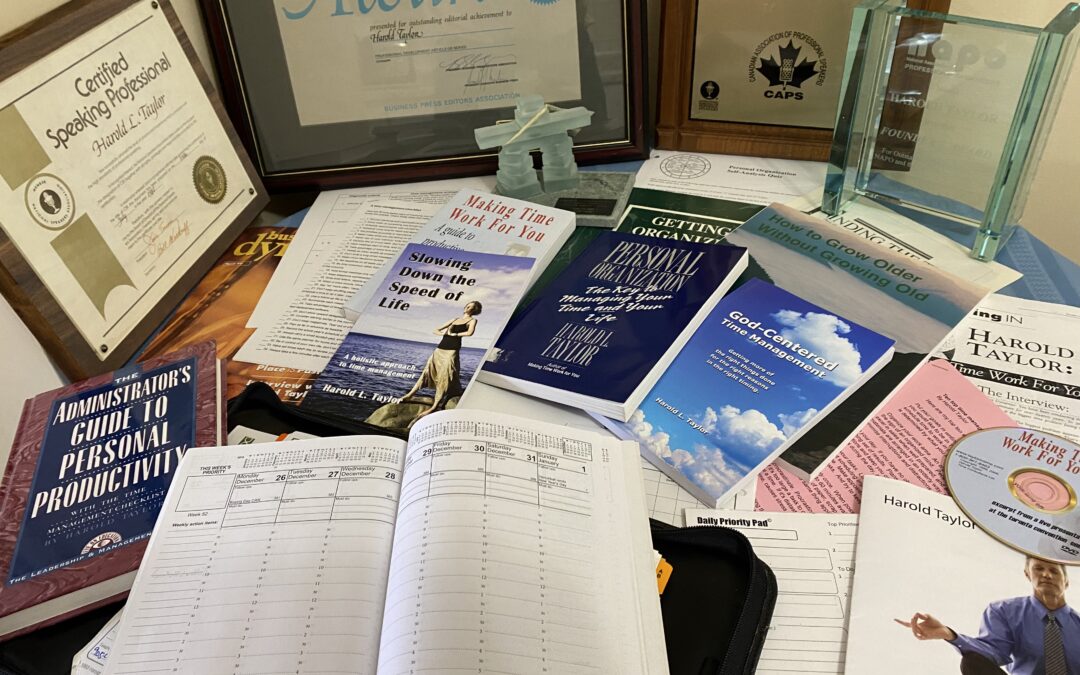What do you do for a living? That’s a question that is easily answered by most professionals, managers, tradespersons, and other workers. “I’m a financial planner, professional organizer, bank manager, accountant, lawyer, salesperson, bookkeeper, maintenance supervisor, truck driver, carpenter, plumber, police officer, airline pilot,” and so on. But for most entrepreneurs, it’s not that easy, because they could be doing a variety of things, usually with a common theme, but involving different skills. In fact, when I started my first company in 1967, I called it Taylor Enterprises because I wasn’t sure exactly what I would be doing. But when I incorporated my time management company in 1981, I called it Harold Taylor Time Consultants Inc., since I thought I knew precisely what I would be doing – providing time management consulting and training. But it didn’t stay that way for long.
The workshops and seminars led to public speaking and keynotes, then time management products such as planners, organizers, telephone log booklets, and so on. That led to training instruments, case studies, and information products. I started writing articles, newspaper columns, special reports, and eventually blog articles, books, and audio recordings. The common theme was “time management.”
But it didn’t stop there. My interests expanded to other topics such as memory training, successful aging, and business management. And that still didn’t include my non-paid work such as volunteering, time management newsletter, church devotionals, pro bono consulting, and so on.
The idea of a portfolio life first appeared in Charles Handy’s book, the Age of Unreason, published originally in 1989 in Great Britain, and by the Harvard Business School Press in 1990. Jeff Goins wrote about Handy’s idea in his book, The Art of Work, published in 2015. A few others followed suit.
Charles Handy described 5 categories of work that make up a person’s work portfolio.
- Wage work, which is payment for time worked.
- Fee work, which is payment for results delivered.
- Gift work, which includes work done for free outside the home, which includes volunteering for non-profit organizations, helping the neighbors and so on.
- Homework, which includes everything from cutting the grass and preparing meals to minding kids – all involving your home, and all unpaid.
- Study work, including training, learning a new language, and so on, which you might have to pay others for – even if it’s just for the books you read.
For most of my time as an entrepreneur I have lived a “portfolio life.” I didn’t know whether to call myself a writer, a speaker, a trainer, a salesman, – and “entrepreneur” certainly didn’t describe what I did for a living. I did several things, initially all revolving around a common theme, and expanding to cover other themes, and finally, distilling out what I enjoy and concentrate on the most – writing.
Delving into the concept of a portfolio life, got me thinking about a few things. Rather than have jobs evolve, as I stated, one of I had planned this before I even started my business. That is, choose a theme – an area of specific interest, which in my case was time management. then look at the various things that would complement the training or be needed by those who would be seeking time management training. It would have been obvious from the start that they would also need what I suggested in my training – whether that was books, guidelines, products, self analysis instruments, information, more in depth training – or whatever- and develop those things at the beginning of my career rather than halfway through it. For instance, my Taylor Time Club – an online resource centre for those who were interested in keeping up to date with time management ideas and suggestions – was both helpful for clients and profitable for the business. The point is, I should have been proactive from the start.
Also, it forced me to think about popular suggestions, such as the 80/20 rule. Most time management books explain the 80/20 Rule, emphasizing that 80 percent of your results are obtained from 20 percent of the things you do. One of the points made is that – theoretically at least – you could eliminate 80 percent of the things you do and only sacrifice 20 percent of the results. If you do that, 80 percent of your precious time would be freed up to devote to more profitable pursuits.
The problem is that money is not the only measure of value. I loved what I did, and still do. In fact, I liked speaking and training so much that in semi-retirement I do it free, as I do much of my writing. At the young age of 88, it gives me something more valuable than money – i.e., health and wellness, self-fulfillment, and a sense of purpose.


Recent Comments